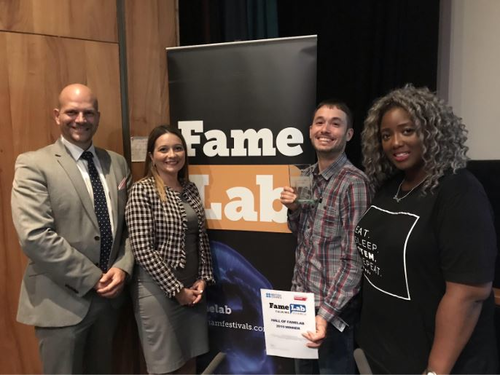
From left to right Tim Slingsby: Director of Skills and Education at Lloyd's Register Foundation, London; Christina Melidou: Partnership manager at FutureLearn, FameLab Greece participant 2008; Anne-Marie Imafidon MBE: Co-founder and CEO of Stemettes.
Yours truly, participated successfully in the science communication event boldly named Hall of FameLab that took place during European Researchers’ Night (a MSCA event) this Oct 27 at the Natural History Museum in London.
FameLab is a science communication competition organized annually since 2005 by the British Council in over 30 countries. Their challenge to the participants is: "Could you inspire and educate a live audience about your work in science, technology, maths or engineering – in just three minutes?"
The regional rounds take place in spring, and then the national winner goes on to participate at the international finals at the Cheltenham festival. I didn’t make it to Cheltenham, but even the participation in the national rounds was amazing as I discovered that I know how to inspire people about science.
Then, I was quite surprised to be selected for a special invitation-only FameLab event, Hall of FameLab, at the Natural History Museum in London. The motto of the event was "the collaborative work of scientists around the world is helping us to understand the interconnected nature of our planet and to conserve the web of natural connections that we depend on to survive." Lyubov Kostova and Ivaylo Slavov from the British Council thought that my work on computer languages and phylogenetics might be relevant to the topic. With the help of some props obtained from Costco’s (a pineapple), I was able to entertain the three judges (photo) and two hundred or so science-hungry museum goers. You can see it all here https://youtu.be/zDRCGTtqgXk.
My talk was about my childhood fascination with the shared ancestry of everything on the Planet. We are literally all relatives: humans and pineapples, even! The second idea of the talk was that language is one of the most powerful instruments that we, as scientists, have to reason about inter-connections. As an illustration, I present a computer language on which I am working, TreePPL.
I am grateful to the public for funding my research, which inevitably helps us, as Homo sapiens, understand our revolutionary place, even if this research has to do with other living organisms. Needless to say, my BIG4 experience in Pensoft shaped me as a scientist and a public speaker and I believe all current Marie-Curie fellows ought to engage in this or in some other form of science communication.
